Effective Strategies for Managing Groundhog Holes
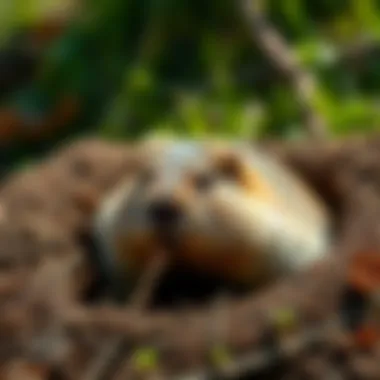
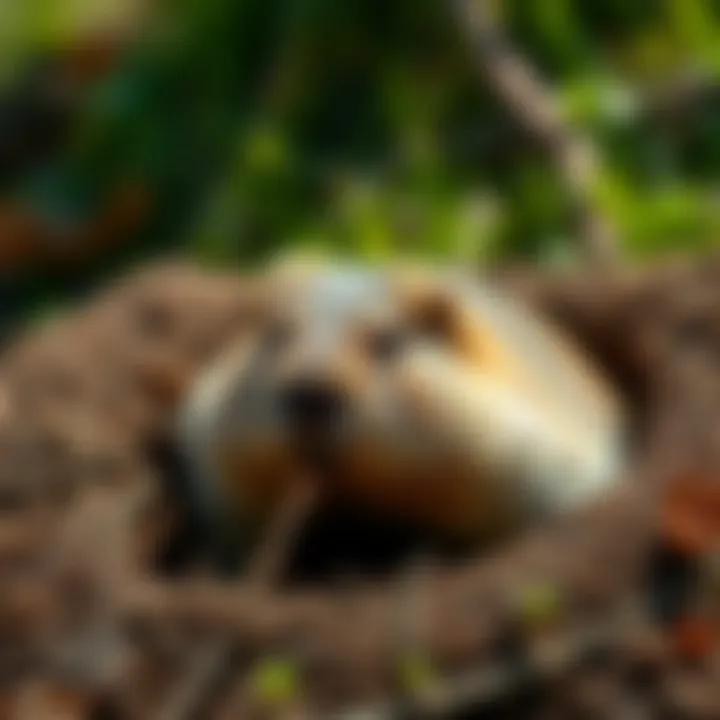
Intro
Groundhogs, often called woodchucks, can turn a serene garden into a battleground. Their burrowing habits not only wreak havoc on lawns but can damage your beloved flowerbeds and vegetable patches. Understanding the flighty nature of these pesky creatures is crucial in finding effective ways to manage their presence. This article guides homeowners and gardening enthusiasts alike through the vital steps in addressing groundhog holes: from comprehending their behavior to discovering actionable removal techniques and prevention strategies. The aim is to equip you with the know-how to tackle groundhog challenges while keeping your garden flourishing and the ecosystem intact.
Understanding the Pest
Identification
Recognizing a groundhog is the first step in mitigation. These rodents are stout, with chubby bodies that can weigh from 5 to 14 pounds. Their fur is typically a blend of brown and gray tones, making them surprisingly good at blending in with their surroundings. A groundhog's most distinctive feature is its broad face, complemented by short legs and a fluffy tail. When spotting these critters, pay attention to their behaviors: they are often seen grazing in the early morning or late afternoon, munching on clover, dandelions, or other greens.
Life Cycle
Groundhogs have a fascinating life cycle worth understanding to address their population effectively. They emerge from hibernation in early spring, ready to assert their territory and search for food. Typically, the breeding season occurs around March and April, with females giving birth to a litter of about 2 to 6 young in May or June. These offspring, known as kits, leave the burrow for the first time at around six weeks old. By late summer, they are fully independent, ready to establish their own burrows, further contributing to the ongoing cycle. Their life expectancy ranges from 3 to 6 years in the wild, but predation can cut this short.
Pest Prevention Strategies
Environment Modification
One way to discourage groundhogs from making themselves at home in your garden is through environmental alterations. Here’s what to consider:
- Remove Food Sources: Groundhogs love a buffet, so keep your gardens tidy. Grasp at fallen fruits or overgrown vegetation. Clear out any potential snacks that might pull them in.
- Maintain a Neat Landscape: An orderly garden can deter groundhogs, as they prefer places with good cover. Trim back bushes and tall grass, clearing the way for visibility.
- Use Traps: Rather than waiting for the problem to escalate, consider humane traps that allow you to catch the critter without causing harm. 🐾 Be sure to follow local regulations on relocation.
Physical Barriers
Implementing physical deterrents is essential in keeping groundhogs at bay. Sometimes a barrier is all it takes:
- Fencing: A sturdy fence at least three feet high can be an effective solution. Ensure it extends several inches underground because groundhogs are diggers.
- Predator Urine: Some gardeners have had success using predator urine, like coyote or fox, as a natural deterrent. Spreading it around your garden can send groundhogs running for cover.
Control Methods
Chemical Control
When all else fails, chemical solutions may be considered. However, it's important to use such methods responsibly:
- Repellents: There are commercial repellents specifically designed for groundhogs. These often use ingredients like capsaicin, which deters animals from feasting on your plants.
- Pesticides: If groundhogs are getting too far along in their destructive tendencies, pesticides may be an option, but it's vital to do so in adherence to local environmental regulations.
Biological Control
Utilizing natural predators can offer a solution without heavy chemicals. If your property allows, encouraging strong owl populations can be an effective tactic. Hawks are another option; consider installing perches to bait them. The presence of these feathered hunters can dissuade groundhogs from lingering too long.
Remember, the goal of an effective strategy is not just to eliminate groundhogs but to create a balance where your garden remains productive.
For further reading, you can check out these resources:
Prelims to Groundhogs and Their Habits
Groundhogs, also known as woodchucks, are fascinating creatures that can be quite the handful for homeowners and garden enthusiasts alike. Understanding their habits is not just a matter of curiosity; it's essential for effectively addressing groundhog holes. Comprehending their behavior allows homeowners to anticipate their movements and nesting locations, leading to informed decisions on control strategies.
Groundhogs are primarily herbivores, enjoying a diet rich in vegetables, fruits, and grasses. Their burrowing habits can wreak havoc on lawns and gardens, leading to unsightly holes and damaged plants. It’s imperative to grasp how these animals function within their environment. This knowledge not only empowers homeowners to tackle infestations effectively but also helps maintain a delicate ecological balance.
In our exploration of groundhogs, we'll tackle foundational aspects of their behavior and the tell-tale signs of their presence. Being able to identify groundhog holes accurately is crucial, as it differentiates between nuisance animals and other common burrowers. Let's dive deeper into these aspects of groundhog life.
Understanding Groundhog Behavior
Groundhog behavior reflects the typical traits of a diurnal herbivore. During the day, they are busy foraging and eating. When any perceived threat arises, they retreat to their burrows, which are often extensive and elaborate. These burrows consist of multiple chambers and escape routes that serve as their fortress against predators.
This behavior, while fascinating, can lead to significant issues for those with vegetable gardens or landscaped yards. A little knowledge about their annual cycle can clarify when they will be most active. Groundhogs typically emerge from hibernation in early spring and begin their burrowing activities shortly thereafter. Understanding this cycle allows homeowners to take preemptive measures to protect their gardens before the groundhogs make themselves comfortable.
Another noteworthy aspect of groundhog behavior is their territoriality. They are known to guard their territory against other groundhogs, which means if one decides to stay in your yard, it may deter others from taking residence. This could be a positive note for residents facing multiple burrow issues.
Identifying Groundhog Holes
Recognizing groundhog holes is a skill that many homeowners can cultivate with observation and patience. Unlike the shallow holes of moles, groundhog burrows are typically deeper and wider, often measuring around 10 to 12 inches in diameter.
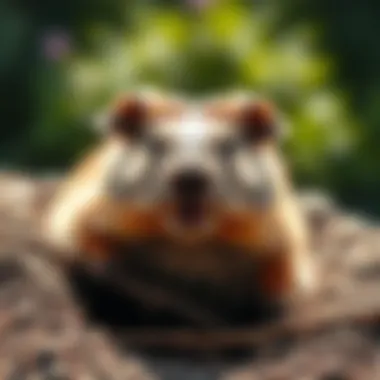

When inspecting your yard, look for the following signs:
- Mound of Dirt: Groundhogs often create a mound of dirt beside their burrow, which can indicate active digging.
- Tracks and Trails: Look for distinctive tracks, which often appear as single-file lines through grass or low-lying foliage.
- Chewed Vegetation: If you notice plants with clean cuts or missing leaves, it could be groundhog snack time.
Identifying these signs early can prevent greater damage to your garden and landscape. Additionally, understanding the locations of burrows helps you establish an effective removal or management plan.
"Proactivity is the best approach in gardening. Recognizing the signs of groundhog activity early can save your plants from being casualties of their appetite."
Assessing the Impact of Groundhog Holes
Assessing the impact of groundhog holes is a vital step in managing your property effectively. By understanding the specific issues caused by these burrowing creatures, homeowners can take targeted action. Groundhogs, often referred to as woodchucks, can wreak havoc on lawns, gardens, and landscaping efforts if left unchecked. Without assessing the situation, a homeowner might find themselves unexpectedly dealing with significant damage.
In evaluating groundhog holes, several key elements stand out:
- Risks to Property: The holes created by groundhogs can compromise the structural integrity of your landscape. These tunnels can erode soil and create uneven terrain, posing risks to both people and pets.
- Cost Implications: Repairing damage caused by groundhogs can be an unexpected expense. The cost of landscaping repairs, reseeding grass, or even foundation work for severely damaged areas can add up fast. Understanding this upfront can guide effective and expedient actions.
- Ecological Balance: Managing groundhog populations without disrupting local ecosystems is crucial. The absence of assessment may lead to misguided control efforts that might impact other wildlife species, introducing unintended consequences.
Damage to Lawns and Gardens
Groundhogs have a knack for digging tunnels and creating holes that can create not only unsightly patches in lawns but also serious damage. Their burrowing can destabilize grassy areas, making them prone to collapse. Here are some specific ways in which the damage manifests:
- Uprooted Plants: These critters aren’t picky eaters. Not only do they tunnel, but they also feast on prized flowers and vegetable plants, resulting in significant loss for gardening enthusiasts. You can find your carefully nurtured zinnias or fresh tomatoes ravaged or entirely devoured.
- Grass Compaction: A concentration of burrows can lead to poor drainage and soil compaction. This alters the growing conditions of your lawn, making it less vibrant and more susceptible to weed growth.
- Pest Attraction: Groundhog holes can attract other pests, including rodents, which may see your yard as a desirable new home. Thus, one hole can lead to multiple pest problems.
Effects on Landscaping
Apart from lawns and gardens, groundhogs can inflict severe effects on more structured landscaping. Here’s a closer look:
- Landscape Aesthetics: Groundhog activity can transform a carefully designed landscape into a patchwork of uneven holes and diggings. This diminishes the visual appeal of your home, potentially affecting your property’s value.
- Inefficient Water Management: Groundhog burrows can interfere with drainage patterns, leading to pooling water in some spots and dry patches in others. It hinders optimal plant growth, resulting in landscaping that doesn’t thrive as intended.
- Increased Maintenance: When groundhogs are around, the effort needed to maintain your garden or outward appearance intensifies. Regular repairs to damaged areas may take up more time, and reseeding may become a constant chore.
"Understanding the impact of groundhog holes not only helps safeguard your property but also informs a proactive strategy for managing these burrowing animals."
Immediate Removal Techniques
When faced with the persistent challenge of groundhog holes on your property, the value of immediate removal techniques cannot be overstated. These approaches serve as crucial first steps not only in safeguarding your garden and lawn but also in setting the stage for long-term management of these burrowing mammals. By acting swiftly, homeowners can mitigate damage and prevent groundhogs from establishing a permanent residence.
Immediate removal techniques can be broadly categorized into two main methods: manual filling of holes and using traps effectively. Each method presents its own set of advantages and considerations. Understanding these strategies allows you to choose the right fit based on your specific situation, your garden's layout, and your personal comfort level.
Manual Filling of Holes
One of the simplest and most direct methods to deal with groundhog holes is manual filling. This technique is not only cost-effective but also provides immediate results in addressing the problem.
Steps to Follow:
- Gather Your Materials: You will need soil, sand, or gravel to fill the holes. Depending on the size of the hole, a garden shovel or spade will be necessary for effective filling.
- Examine the Surroundings: Before sealing a hole, it’s essential to verify whether the groundhog is still present. Watch for signs like disturbed soil or fresh burrowing activity. Haste in filling a hole may inadvertently trap a groundhog inside.
- Fill the Hole: Carefully compact the soil or gravel into the hole. Make sure to eliminate air pockets to prevent future sinking and to provide a solid barrier against further burrowing. A natural approach may include using a mixture of soil and gravel, which not only fills the hole but also creates a tougher barrier.
- Monitor for Activity: After filling the hole, keep an eye on the area for a few days. If new digging occurs, it may be time to consider more proactive methods like trapping.
Considerations: While manual filling can be effective, it’s essential to recognize its limitations. If groundhogs are numerous or persistent in your area, merely filling holes may not suffice. Monitoring soil moisture and compaction can be key. If the ground stays too soft, you might face new problems in no time.
Using Traps Effectively
For those looking at a more direct resolution, using traps effectively can be a solid option. Trapping not only allows for removal but also offers a way to manage the population responsibly.
Using Traps – A Guided Approach:
- Choose the Right Trap: Select a sturdy trap designed specifically for groundhogs, such as the Tomahawk live trap. Look for sizes around 32 inches in length. Always ensure that it is humane and compliant with local regulations.
- Locate Strategic Areas: Set the trap near active burrows or existing trails. Groundhogs tend to follow habitual paths, making these locations prime sites for trapping.
- Bait the Trap: Place bait inside the trap. Groundhogs are attracted to fresh fruits or vegetables. A slice of apple or some cantaloupe works wonders as bait.
- Set and Check: After setting the trap, monitor it regularly. Checking frequently not only ensures the animal does not suffer unnecessarily but also prevents a potential buildup of stress for others in the vicinity. Be prepared to relocate caught groundhogs according to local guidelines, ensuring their humane treatment.
It is essential to approach trapping with care, ensuring that all local wildlife regulations are followed. Failure to do so can lead to fines or further complications.
Final Thoughts
Both manual filling and trapping are immediate responses that serve an essential role in managing groundhog populations. The key is to remain vigilant and be flexible in adapting these techniques to match your unique gardening environment. By taking swift action, you not only protect your plants but also contribute to a balanced approach to wildlife management.
Long-term Solutions for Groundhog Management
Managing groundhog populations goes beyond quick fixes and temporary solutions. Long-term strategies focus on creating a sustainable environment that deters groundhogs from making a home in your yard. Understanding the importance of these strategies enables homeowners to achieve lasting peace without harming the natural ecosystem. In this section, we’ll explore two main approaches: creating physical barriers and utilizing natural repellents.
Creating Physical Barriers
Physical barriers are one of the most effective ways to prevent groundhogs from entering your garden or yard. These barriers not only help to manage existing populations but actively discourage others from moving in. Here are several methods to consider:
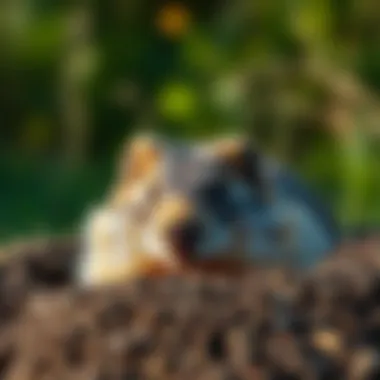
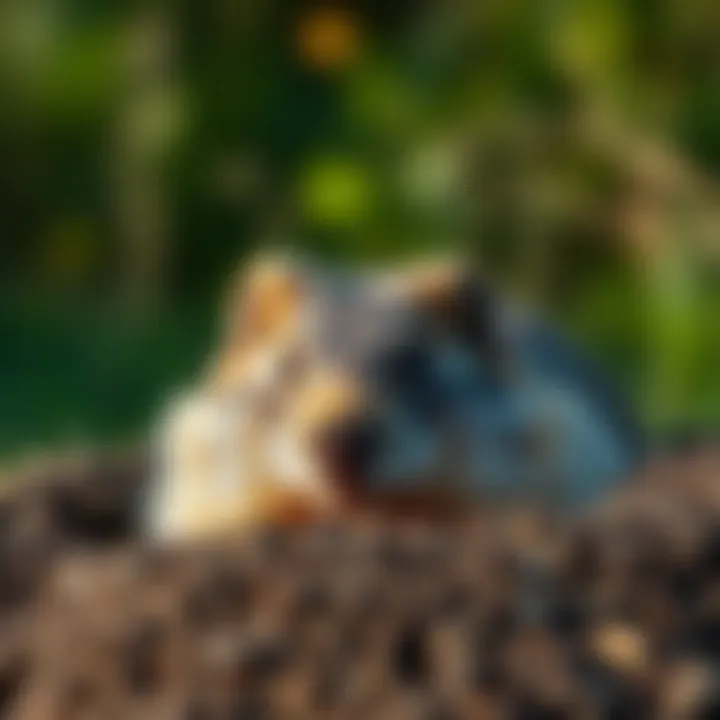
- Fencing: Install a robust fence around the perimeter of your garden. The fence should be at least three feet high, with the bottom buried about a foot underground to thwart any burrowing attempts. Using strong materials like chain link or welded wire can provide durability against groundhog claws.
- Barrier Plants: Consider planting certain species around your garden that groundhogs dislike. Plants such as lavender and mint have scents that can repel these critters, creating a natural barrier.
- Trenching Solutions: If you want to get more serious, dig a trench around your property. Lining it with rocks or gravel makes it difficult for groundhogs to dig their way through.
In the long run, creating physical barriers effectively reduces the chances of groundhog-related damage. Implementing these strategies offers a methodical approach to protect both gardens and landscaping investment, allowing your diligent efforts to bear fruit.
Utilizing Natural Repellents
Natural repellents serve as an eco-friendly way to keep groundhogs at bay. These methods not only help in managing groundhog numbers efficiently but also align with a more sustainable lifestyle by avoiding toxic chemicals. Some tried-and-true natural deterrents include:
- Castor Oil: Groundhogs have a strong aversion to castor oil. Mixing castor oil with water and spraying it around the garden can deter them from digging.
- Cayenne Pepper: A spicy deterrent, sprinkling cayenne pepper around the perimeter can create an unpleasant experience for groundhogs. Just be careful not to harm beneficial insects.
- Human Hair: Surprisingly, human hair can act as an effective repellent. Collect hair clippings and scatter them around your garden. The scent gives the impression of human presence, which groundhogs instinctively avoid.
Ultimately, combining these natural repellents with other methods creates a layered defense against groundhogs. By implementing both physical barriers and natural deterrents, homeowners can create an inhospitable environment, encouraging groundhogs to find new habitats elsewhere.
"Prevention is better than cure."
Grip the reins of your land by applying these long-term strategies. They not only protect your estate but also contribute to the wider ecosystem.
For more comprehensive understanding, you can visit Wikipedia on Groundhogs. Additionally, check out National Park Service for insights on wildlife management.
Ecological Considerations in Groundhog Control
Understanding the ecological impact of managing groundhog populations is essential for homeowners and gardening enthusiasts. While it’s tempting to look at groundhogs merely as nuisances, these creatures play a unique role in their ecosystems. Addressing groundhog holes without considering ecological balance can lead to unintended consequences that may outweigh the initial benefits.
Understanding Ecosystem Balance
Groundhogs, or woodchucks, are more than just diggers— they are an integral part of the ecosystem. Their burrowing behavior aerates the soil, which can promote healthier plant growth. Moreover, they serve as prey for several predators, including foxes and hawks. Disrupting their population can cause a ripple effect throughout the food chain.
By understanding the balance of your local ecosystem, homeowners can make more informed decisions. Instead of going for outright removal measures, consider a balance between managing groundhog populations and preserving their rhythm in nature. This approach may involve strategies that deter groundhogs without causing harm, like planting barrier plants or using fencing materials designed to keep them at bay.
"Nature operates on a fine line; disrupt one element, and the whole system can waver."
Impact of Removal on the Environment
Removing groundhogs can have significant environmental consequences. Some may think that trapping and relocating them helps, but the reality is far more complex. When groundhogs are removed from their territory, several issues can arise. The first is the potential open niche for other pests to occupy this space. For instance, voles or rabbits may take advantage of the vacuum left by groundhogs, which could result in different types of damage to gardens and lawns.
Additionally, the relocation of groundhogs often doesn’t guarantee their survival. Many relocated animals fail to adapt to new environments, leading to a loss of life that could have been avoided.
Homeowners considering removal should also weigh the social interactions of their local animal communities. If groundhogs are common, they often have set pathways and familiar territories that help maintain a balance. Removing them can create stress for other wildlife species, leading to increased competition for resources, such as food and shelter.
Legislation and Ethical Considerations
Groundhog control is not just about managing pests; it intertwines with various local laws and ethical practices. Understanding legislation surrounding wildlife control is crucial for house owners and gardening enthusiasts who seek to balance effective management of groundhog populations with respect for ecosystem integrity. Ignoring these elements can lead to legal repercussions or damaging effects on local wildlife.
Local Regulations on Wildlife Control
When tackling groundhog issues, one cannot skim over local regulations governing wildlife control. Many communities have established rules that dictate how property owners can address rodent problems. For instance, certain regions could require permits for trapping or relocating wildlife, while others might have specific guidelines about what to do with trapped animals.
Some common regulations may include:
- Trapping Restrictions: Various states have laws about the types of traps that can be used, ensuring humane treatment.
- Relocation: Moving a groundhog to another area is often illegal without the proper permits, as this can disrupt local populations.
- Seasonal Limits: Hunting or trapping might only be permissible at certain times of the year, so awareness of these seasons is vital.
Homeowners are encouraged to check local wildlife management websites or gov listings for comprehensive guidelines. Understanding these legalities not only ensures compliance but also promotes ethical practices when dealing with wildlife.
Ethical Trapping Methods
As an essential aspect of groundhog control, ethical trapping methods consider the well-being of the animals while addressing the concerns of homeowners. Traps must be designed to minimize suffering, offering a quick and humane option for dealing with unwanted wildlife.
Effective ethical traps may include:
- Live Traps: These cages allow for gentle capture without inflicting harm, enabling the animal to stay alive while being removed from the property.
- Scented Bait: Utilizing substances like peanut butter or cabbage, placed strategically inside traps, encourages groundhogs to enter without fear of injury.
- Regular Checks: Traps should be monitored frequently to reduce the animal's stress and ensure timely transfer once captured.
Employing these practices not only abides by local regulations but conveys respect towards nature's role within our surroundings. A balance of community and individual efforts in addressing population control equates to more effective and sustainable outcomes for everyone involved.
Advice for Gardening Enthusiasts
Gardening is a delightful pursuit, but it can quickly become a tug-of-war when groundhogs invade your meticulously tended space. Understanding how to manage these pesky critters through strategic gardening choices can save you from frustration and ensure a thriving garden. The advice presented here aims to empower homeowners and gardening enthusiasts to mitigate the risk of groundhog damage while fostering a vibrant and sustainable ecosystem.
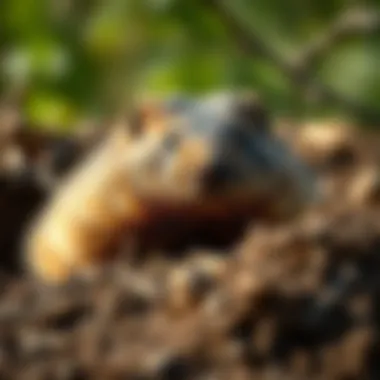

Choosing Resistant Plants
Selecting plants that are less appealing to groundhogs can be an effective defensive tactic. It’s essential to research plant varieties that groundhogs tend to avoid. Typically, they are less interested in plants that are fragrant, bitter, or have tough textures. For instance, herbs like rosemary, sage, and lavender often deter these critters due to their strong scents.
Consider the following resistant species:
- Marigolds - Their pungent smell can act as a natural deterrent.
- Daffodils - These flowers are toxic to many pests, including groundhogs.
- Thyme - A resilient herb, perfect for a kitchen garden.
Incorporating these types of plants not only reduces the likelihood of groundhog visits but also introduces a variety of textures and aromas to your garden. When choosing resistant plants, it's also wise to consider your local climate and soil conditions to ensure these plants flourish.
Companion Planting Strategies
Companion planting is a method that promotes plant growth by pairing compatible species together. This approach can also trick groundhogs, as certain plants can mask the smells of those that attract them, thereby protecting your cherished vegetables and flowers.
Benefits of Companion Planting:
- Pest Deterrence: Some combinations, like cucumbers paired with nasturtiums, have been shown to deter groundhogs.
- Enhanced Growth: Plants like tomatoes thrive near basil, creating a win-win for your garden.
- Soil Health: Pairing certain plants can enrich the soil naturally, promoting overall vigor.
An example of this could be that if you place onions nearby to carrots, not only will your carrots grow better, but also the strong smell of onions can keep groundhogs at bay. Another interesting practice is interspersing hearty plants with tender ones; the tough texture can act as a fortress, making it less appealing for groundhogs.
By incorporating these strategies into their gardening practices, enthusiasts can create environments less hospitable to groundhogs while still allowing for a flourishing landscape. Through maintaining diversity and resilience, gardeners can foster a robust community that thrives amidst the challenges posed by wildlife.
Community Approaches to Groundhog Control
Managing groundhog populations isn’t just an individual task; it’s a community concern, too. When homeowners unite to tackle the issue, the effectiveness of groundhog control methods often increases significantly. Working together allows individuals to share not only experiences but also solutions that minimize damage to gardens and lawns. By adopting a community-focused approach, neighborhoods can foster better management tactics that benefit all residents while maintaining a harmonious relationship with local wildlife.
Collaborative Neighborhood Efforts
Taking on groundhogs single-handedly can be quite the uphill battle. Often, these critters don’t stick to one garden or yard; they traverse through multiple properties. This is where the power of a collective effort comes into play.
Imagine a neighborhood meeting where residents discuss their experiences with groundhogs. Sharing which tactics worked or didn’t can save others time and resources. Furthermore, communal initiatives could include organizing trap loans, wherein those who have purchased traps allow others in the neighborhood to borrow them instead of everyone investing in their own. If a system of communication is established, warnings about groundhog sightings can be circulated rapidly, making it easier for households to act promptly.
Key Benefits of Collaborative Efforts:
- Knowledge Sharing: Residents can discuss what has worked for them, generating a treasure trove of insights.
- Economies of Scale: Resources such as traps or deterrent plants can be purchased in bulk, cutting down individual costs.
- Moral Support: Dealing with pests can be frustrating. Knowing others are in the same boat can ease the burden.
Shared Resources and Knowledge
In addition to collaborating on control measures, pooling resources presents another valuable avenue for effective groundhog management. Availability of information, such as guides about groundhog habits or effective deterrents, can be pivotal.
Creating a community handbook that outlines local groundhog behaviors, preferred feeding habits, and effective control strategies could be immensely beneficial. Adding a section for frequently asked questions can help demystify the process for newcomers unfamiliar with these creatures. Additionally, holding educational workshops led by pest control experts can provide invaluable insights that may not be accessible otherwise.
Building shared resources creates a sustainable knowledge base that can evolve over time. Here are a few ideas to consider:
- Organize community workshops on gardening techniques that successfully deter groundhogs.
- Set up information sessions with local wildlife experts who can provide practical advice on humane control methods.
- Initiate online forums or social media groups where residents can share tips, updates, and experiences related to groundhog management.
The End and Summary of Key Points
In wrapping up the discussion around groundhog holes, it's crucial to underscore the importance of addressing these pesky intrusions with both a strategic and considerate approach. This section not only highlights the effectiveness of various techniques but also reinforces a couple vital considerations for homeowners looking to safeguard their landscapes.
Groundhogs, like any wildlife, should be appreciated for their role in the ecosystem, yet their digging habits can wreak havoc on lawns and gardens. Understanding their behavior is foundational, and the methods discussed throughout this article provide practical solutions. From immediate removal techniques such as manual filling of holes and using traps, to longer-term strategies that involve creating barriers and using natural repellents, the tools are available for effective management.
Not to be overlooked, the ecological balance must guide our actions. Homeowners should weigh the consequences of their interventions, keeping an eye on how their strategies fit within the larger environment. This means not only being aware of local regulations regarding wildlife control but also ensuring that any methods applied do not lead to unforeseen negative impacts on the surrounding ecosystem.
- Understanding Groundhog Behavior: Knowing how and why groundhogs dig is essential for tailoring effective removal methods.
- Practical Techniques: Implementing both immediate and long-term solutions is vital to prevent re-infestation.
- Ecological Awareness: Always consider the bigger picture. How do your methods affect wildlife, neighboring properties, and the general environment?
These insights aim to empower homeowners with the right knowledge to address groundhog holes successfully. With careful planning and execution, you can safeguard your yard while respecting the local wildlife.
Recapping Effective Techniques
When it comes to the effective management of groundhog holes, several strategies remain paramount:
- Manual methods: This involves filling in holes promptly after identifying them, which can deter groundhogs from returning.
- Trapping: Using traps with appropriate bait allows for humanely addressing the problem. Ensuring the traps are checked regularly is vital for effectiveness.
- Physical barriers: Putting up fences or using other forms of barriers can prevent groundhogs from infiltrating gardens.
- Natural repellents: Certain scents, such as those from garlic or cayenne pepper, can be sprinkled around gardens to naturally deter them.
By employing these techniques strategically, homeowners can find a balance between taking back their gardens and maintaining ecological harmony.
Encouraging Sustainable Practices
To promote a sound approach to managing groundhog populations, sustainable practices should be encouraged. Here are some ways to ensure the methods used remain environmentally friendly:
- Educate Yourself and Neighbors: Knowledge is power. Share insights and strategies within your community to build collective problem-solving efforts.
- Utilize Native Plant Species: Encourage planting native flora that naturally thrives in your region and is less appealing to groundhogs.
- Focus on Habitat Management: Maintain your yard in a way that eliminates potential nesting sites. Clear away debris or tall grasses where groundhogs might burrow.
- Engage with Local Wildlife Experts: Consulting with wildlife control professionals or local extension services can provide tailored advice suited to your area’s specific challenges.
Fostering these sustainable practices not only helps control groundhog populations but also underscores our responsibility as stewards of the environment. By considering both human needs and the natural world, we can create a harmonious coexistence.







